What is air conditioning system or air conditioner? It is very simple as we all know that we need to switch on if we feel hot. isn’t it? But how does air conditioner or AC system works? Any idea? We have learned how cooling happens. But here we are going to learn how air is cooled and how heat transfer is happening in air conditioning machines, what is the definition of AC and many more! Our room becomes comfortable due to air conditioner units although outside is very hot. We will see how air conditioner works in this chapter with detailed functions of parts of air conditioners.
What is an AC or Air Conditioner Unit? Definition
Air Conditioner Unit (AC) Basics
An air conditioner (AC) is a device that is designed to maintain comfortable indoor temperatures, especially during scorching summers. It functions by extracting heat from the interior space and expelling it outside, thus creating a cooler and more pleasant environment.
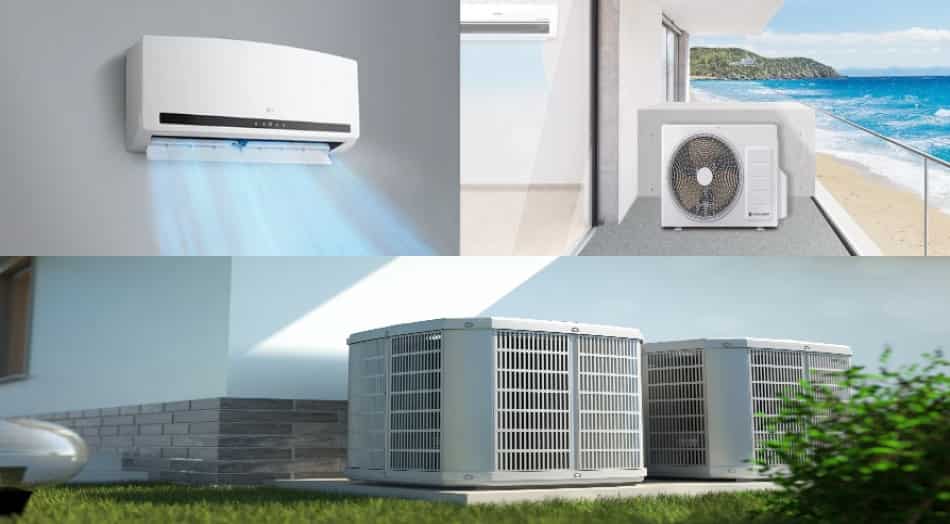
AC or Air Conditioner Unit Definition
Before going to the machine, let’s see air conditioning system first! Air conditioning is a process that cools or heats, freshens, filtrate, circulate of air and control its moisture content based on the requirements.
Air conditioner (sometimes called AC, A/C, or air con) is a machine or system that is used to condition (cools or heats) the required space by removing the existing heat (for cooling) or adding extra heat (for heating) and control the moisture content in the space. It is basically a part of HVAC system.
Parts of Air Conditioners or AC system
Now, we will see how a simple air conditioner works in our house to have a practical understanding. Let’s try to understand the different parts of air conditioners and what are the functions of each part. There are four (4) major components in air conditioners:
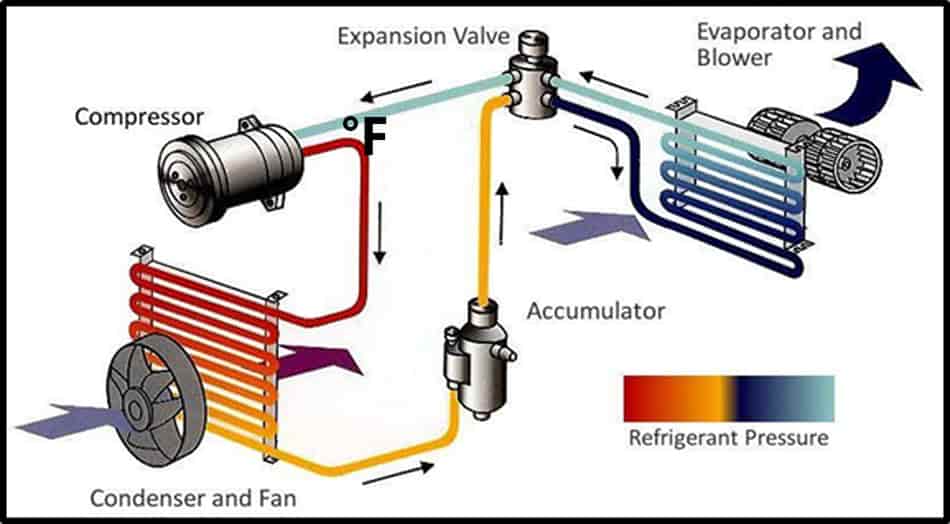
- Evaporator
- Compressor
- Condenser
- Expansion valve
Along with the main components, all other parts of air conditioners are
- Evaporator fan
- Condenser fan
- Filters
- Refrigerant
- Electric motors
- Controls
- Refrigerant pipes
- Ducting, if applicable
- Drain pipes
- Electrical cables
- Control cables
We will discuss the basic description and functions for all of the parts of air conditioner unit in this article.
How Does Air Conditioner or AC System Works?
In this session, we will learn how does air conditioner works. When we feel uncomfortable due to high ambient temperature, what will we do? We simply switched on our air conditioning remote and get the cold air. Now, have you thought about it? Why does cooling happen? Let’s try to understand the cooling process with a simple explanation.
If you take a small amount of medicated spirit, you will see your palm will get cooled. How it is cooled,
- Spirit evaporates at normal pressure & temperature.
- For this evaporation, the spirit takes heat from the palm
- Palm loses heat & gets cold.
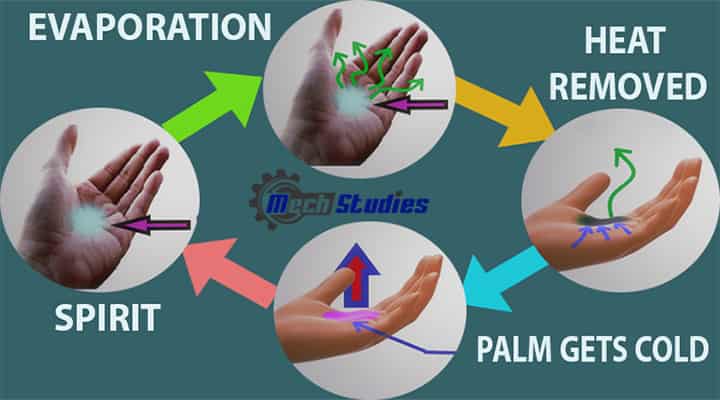
Before going to the actual process of how does air conditioner works, we have to know a few basic details. Let’s see the basics first!
Basics of How Do Air Conditioners or AC System Work
All air conditioners work based on the refrigeration cycle. We have already learned the vapor compression cycle or vapor absorption cycles. In this lesson, we will consider the vapor compression system which is widely used in various industries. Refrigerant circulates through evaporator, compressor, condenser, expansion valve and continues this cycle.
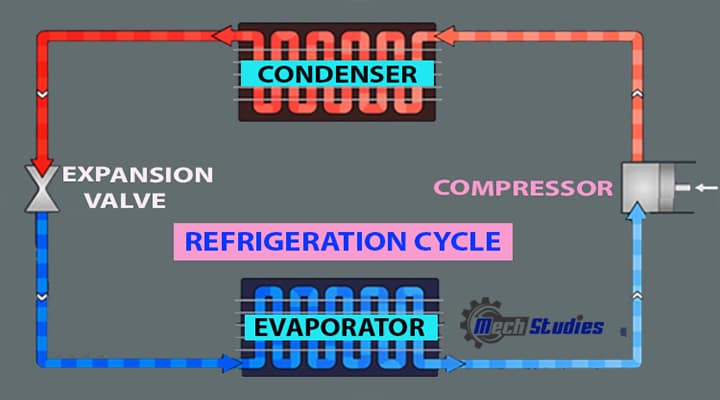
Let us see the various parts or components of an air conditioner at a glance which is further describe in the next clause:
- Evaporator Coil: This coil is located inside your home and is responsible for absorbing heat from the indoor air. It cools the air as it passes over it.
- Compressor: Often referred to as the heart of the AC, the compressor pressurizes the refrigerant, transforming it into a high-temperature gas to prepare it for the next phase of the cooling cycle.
- Condenser Coil: Positioned in the outdoor unit, this coil facilitates the release of heat absorbed from the indoor air. It condenses the hot refrigerant gas back into a liquid.
- Refrigerant Lines: These lines transport the refrigerant between the evaporator and condenser coils, ensuring a continuous cycle of cooling.
- Expansion Valve: Located between the evaporator and condenser coils, the expansion valve regulates the flow of refrigerant, controlling its pressure and temperature.
- Fan: Fans in both the indoor and outdoor units help circulate air and dissipate heat from the condenser coil.
- Thermostat: The thermostat acts as a control device, allowing you to set and regulate the desired indoor temperature.
- Air Filters: These filters remove dust, debris, and allergens from the air, ensuring clean, healthy, and efficient cooling.
- Ductwork: The ducts distribute the cooled air throughout your home, enabling even and consistent cooling in different rooms. However, split AC doesn’t require any ductwork.
- Control Panel: The control panel houses the settings and controls for your AC, allowing you to adjust modes, temperatures, and fan speeds.
Description of Air Conditioners or AC Unit Parts
01. Evaporator
The evaporator is a cooling coil and acts as a heat exchanger in the AC system. The main functions are :
- To collect or absorb the heat from the area which needs to be cooled.
- The evaporator changes or transforms the refrigerant from the liquid to a vapor.
- In the evaporator, the temperature of the refrigerant should continually much less than the surrounding temperature in order to make continuous heat flows to the refrigerant.
- The surrounding medium can be water or air based on the application, and the evaporator absorbs heat from air or water whatever is there. In our example, we have considered simplest air conditioner which cools air.
It is placed in the indoor unit. The indoor unit is located inside the room which needs to be air-conditioned. This coil is having fins to increase the surface area. Surrounding air will lose heat and become cool.
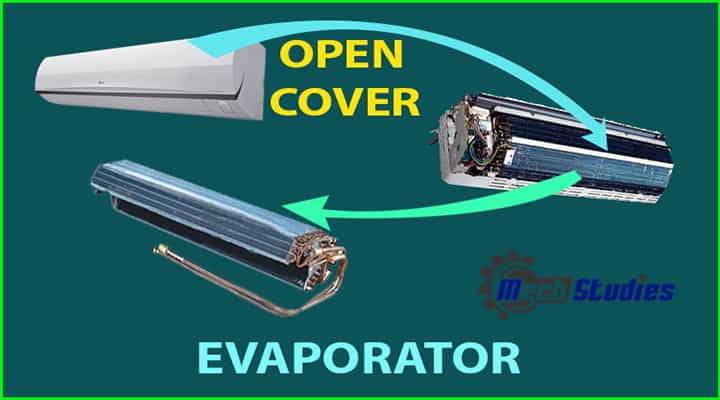
This cool air will then be circulated by a blower to the space to be conditioned. This blower or fan is known as an evaporator fan. Don’t be confused between blower and fans, we will learn the difference between blower and fan later on.
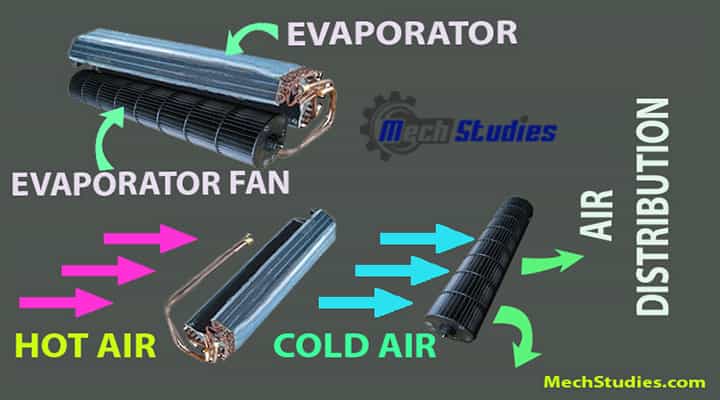
Evaporator Fan
Air Distribution Scheme will be as above.
02. Compressor
A compressor is the most important part and it is called the heart of the air conditioning system. The main functions of the compressor are:
- To draw continuously the refrigerant vapor from the evaporator
- Maintain a low pressure and temperature inside the evaporator. We know that high pressure and high-temperature fluid always flow towards low pressure and low temperature respectively.
- In the compressor, the refrigerant vapor pressure & temperature will be increased and a pressure & temperature difference between the evaporator & compressor will be always maintained respectively.
Due to the difference in pressure & temperature, phase changes from liquid refrigerant to vapor refrigerant will be faster.
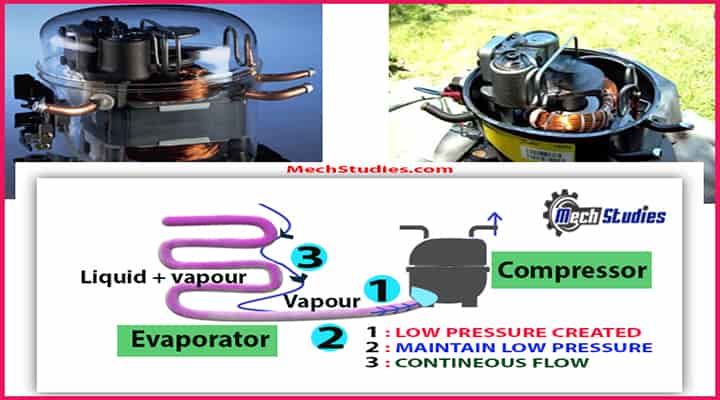
Then, the compressor raises the pressure of the refrigerant to which it can be condensed by rejecting heat to one heat exchanger i.e. condenser.
03. Condenser
The condenser is simply a heat exchanger where gasses are changed into a liquid. Refrigerant undergoes a phase change in the condenser.
- The refrigerant vapor released from the compressor is in superheated conditions.
- Firstly, the condenser reduces the heat content from the refrigerant vapor & makes it saturated vapor.
- With further reduction of heat content from the vapor, the phase changed into the liquid.
- To make this heat transfer fast, the surface area of the condenser is increased with fins.
- During this phase change, a slight vacuum is created within the condenser, hence, the condensation will be faster.
- This heat is rejected to the atmosphere by using condenser fans.
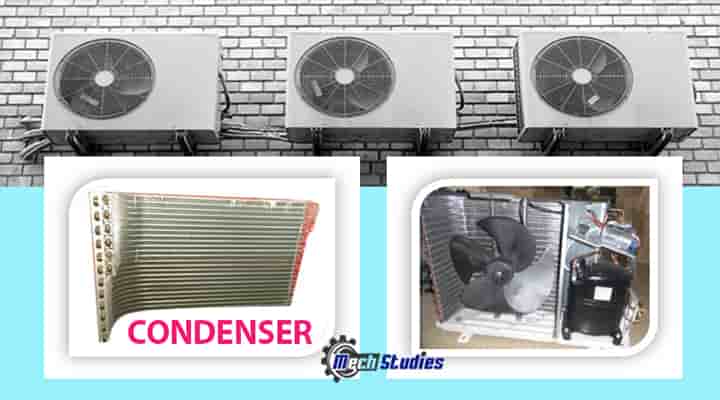
04. Expansion Valve
The expansion valve is located between the condenser and evaporator. The main function shall be as follows,
- To maintain constant pressure and temperature
- To control the flow of refrigerant from the condenser to the evaporator
- To reduce the high-pressure liquid line to low pressure in the evaporator
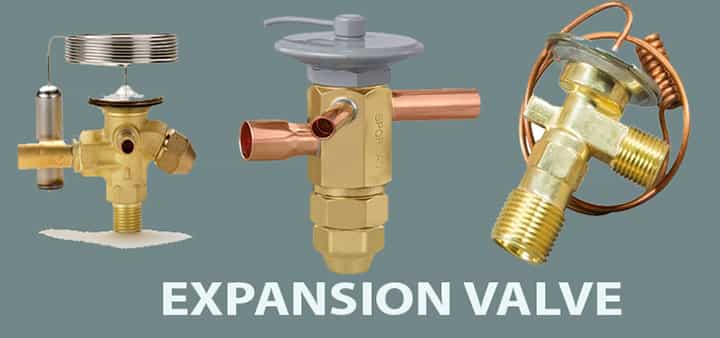
05. Blower
A blower is used in the air conditioners, to circulate the air. The blower continues to flow the air as well as it sucks the hot air too and maintains proper air circulation.
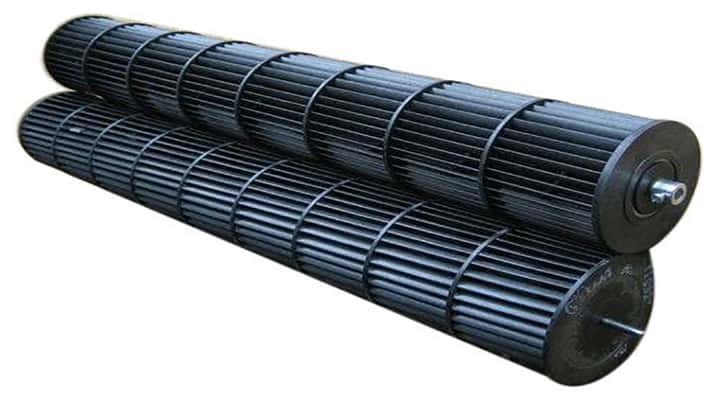
06. Condenser fans
The condenser releases the heat from the condenser coils. Now, condenser fans are necessary to increase the rate of cooling and boost the system.
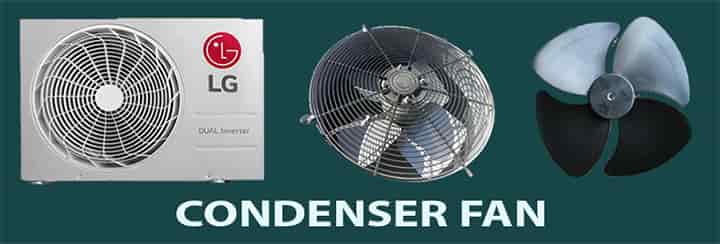
07. Filters
Due to the dust particles or other pollutants, it is very much necessary to filtrate the air before we breathe or use it. Remember filter cleaning is necessary to increase the efficiency as well as the indoor air quality. In the air conditioning system, various kinds of filters are used to filtrate the air. Filters maybe
- Panel filters
- Prefilters
- Activated carbon filters
- Fine filters
In bigger units like AHUs, bag filters are used to get good IAQ. If the system uses for medical aspects, a very high efficient HEPA filters have been used.
08. Refrigerants
Refrigerant is the main working fluid in the air conditioning system. It changes its phase very quickly. Normally, the following refrigerants are widely used:
- R1234yf
- R134a
- R410a
- R407c
Refrigerant is chosen in such a way that it will not affect the environment, like less ozone depletion potential and less global warming potential.
09. Electrical Motors
The electrical motors for evaporator fans, condenser fans, and compressors are required.
10. Controls
Monitoring and controlling air temperature in air conditioning is necessary and it is done by a thermostat. The thermostat senses the temperature of the conditioned space and turns the blower on or off based on the cooling requirements.
- If the thermostat set temperature is higher, loads will be less
- AC loads will be more for lower thermostat temperatures.
11. Pipes & Cables
Piping, cabling, etc. are required to complete the air conditioning system.
- Electrical cables are required to connect to the main power source. In addition, both indoor and outdoor units are also connected with electrical cables.
- Refrigerant piping along with fittings, insulations, etc. are provided between the indoor unit and outdoor unit.
- The condensate drain pipe from the indoor units is provided to drain out the water.
You can explore AHU video with Site Tour
Working Principle for How Does Air Conditioner Works
How do you describe the air conditioning system?
Step#1: Heat absorbed in the evaporator.
At normal pressure and temperature, refrigerant starts evaporating in the evaporator coil and latent heat of evaporation takes adjacent surface or adjacent areas or surrounding air. Air is becoming cool by releasing heat and refrigerant becomes heated by taking heat.
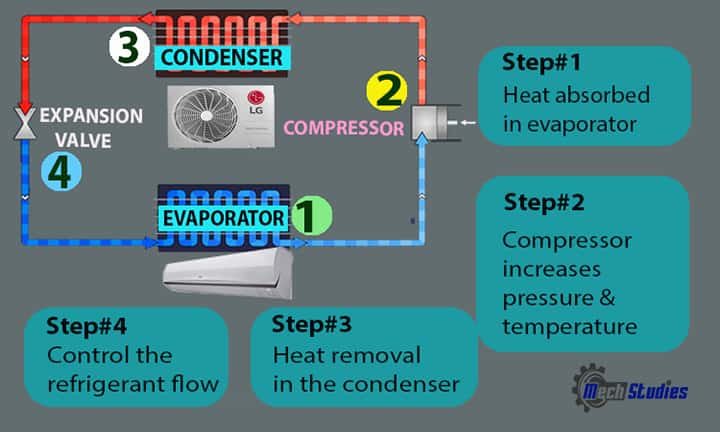
Step#2: Compressor increases pressure & temperature
When the compressor starts rotating, there will be negative pressure, and refrigerant vapor is forced to enter the compressor. Once refrigerant vapor enters, the compressor compresses the gas, and its pressure and temperature increase.
Step#3: Heat removal in the condenser
High pressure and high-temperature refrigerant vapor then pass through the condenser. Here, the refrigerant vapor is changed into liquid and releases heat into the atmosphere.
Step#4: Flow control
After heat removal, the refrigerant enters into the expansion valve. This expansion valve throttles and controls the flow and sends the refrigerant to the evaporator. This process continues and, in this way, the air conditioner works.
Working Principle Scheme of AC System or Air Conditioner
It’s a very easy process and explained in a very simple way with relevant images to understand better in step by step. Refrigerant is pumped through tubing in the circuit to start the refrigeration process.
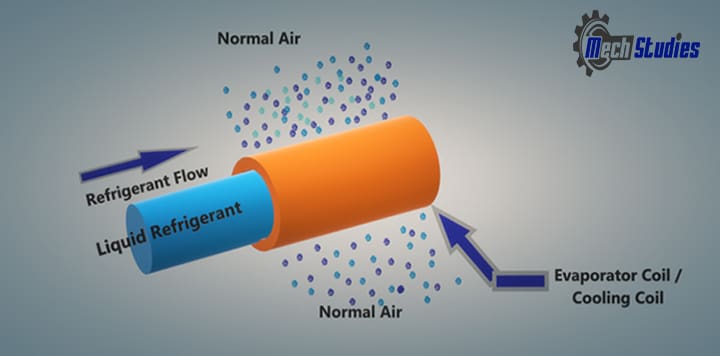
This refrigerant is cold and starts changing its phase in normal conditions.
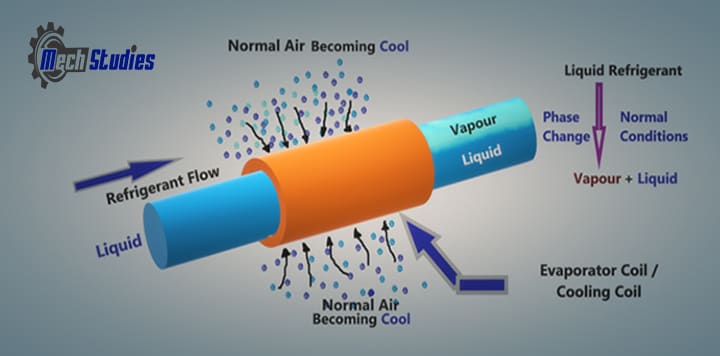
In Evaporator, the Refrigerant takes heat from adjacent air and starts evaporating at normal pressure & temperature, and changes its phase from liquid to vapor.
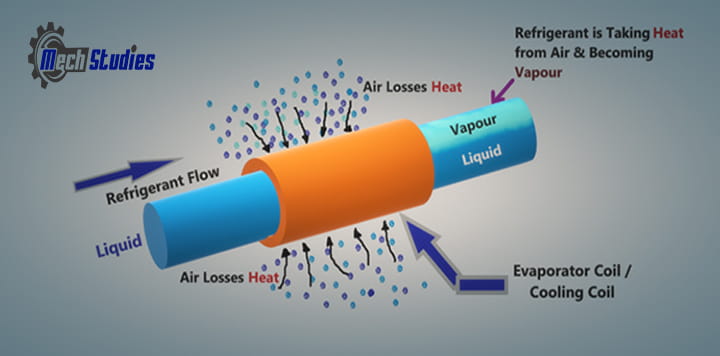
The compressor creates a low pressure at the inlet and maintains a constant flow in the circuit and compresses the refrigerant vapor as well as increases its pressure and temperature.
After the compressor, refrigerant vapor moves to the condenser coil and releases heat into the atmosphere.
The vapor travels to a compressor that pressurizes it and moves it through the condenser coil, where it releases heat, which is expelled outside.
The refrigerant then moves through an expansion valve which converts it to a low-pressure and maintains the required flow in the circuit. This cycle works continuously in all air conditioner units. A blower circulates air through the coil and air gets cooled. Cool air gets hot in the room, goes upside and is sucked by the blower and again it goes through the evaporator coil, gets cooled, and repeats the process.
Understanding How Does Air Conditioner Works with Animation
We have explained how does air conditioner works in step by step. Now, the same working principle can be described in simple animation also, to understand the process visually. Learn Engineering has created a very nice representation of How Air Conditioner Works. Check it out!
Explanation of Air Conditioners for AC Working Process
There is various type of air conditioners, from simple system to complex air conditioning system. These all are used based on the industry requirements, for example
- Split Air Conditioners
- Package air conditioners
- Chilled water system and many others.
The basic working procedure is explained in very brief to get basic knowledge. Let’s start with split air conditioners!
Split Air Conditioners
A split air conditioner consists of two units, an indoor unit, and an outdoor unit and it is normally used in residential applications, and small-scale industrial applications.
Indoor Unit
The indoor unit is located inside the room which needs to be air-conditioned and it consists of filters, cooling coils i. e., an evaporator, an expansion valve, and a blower. The refrigerant evaporates and absorbs heat from the room air. Room air becomes cold by losing heat and circulate by a blower into the room.
After absorbing heat, the refrigerant will go to an outdoor unit for releasing heat into the atmosphere. Inside air will be recirculating and again will pass through the evaporator and maintain constant cooling inside the room.
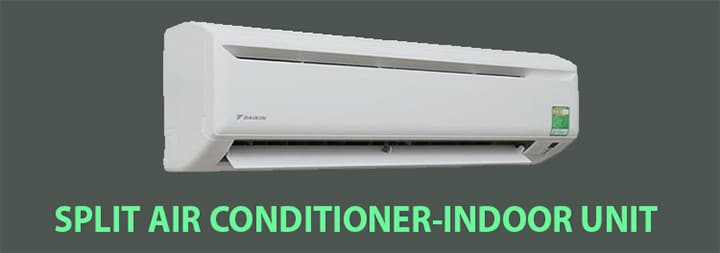
Outdoor Unit
The outdoor unit is located outside the room to release the heat. It consists of a compressor, condenser coil, and condenser fans. The heat absorbed by refrigerant from the indoor unit (evaporator coil) will reach to the compressor in the outdoor unit
The compressor, the heart of the air conditioning system, circulates the refrigerant throughout the system. The compression of refrigerant happens in the compressor and pressure, the temperature of the refrigerant is increased. High pressure and temperature refrigerant then moved to the condenser coil i.e., condenser.
As the refrigerant passes through the condenser coil, condensing fans deliver ambient air across the condenser coil and cool the refrigerant and it again comes back to the evaporator coil through an expansion valve. In this process, the heat from the inside area will be removed to the atmosphere.
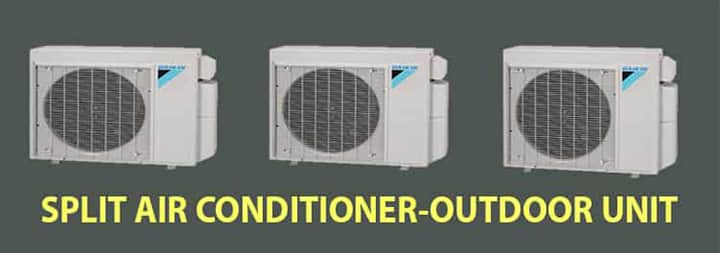
Normally split air conditioners are available as;
- 1 TR (Ton or Tonnage of refrigeration)
- 1.5 TR
- 2.0 TR
- 2.5 TR
- 3.0 TR (a few manufacturers are making this capacity as well)
These type of split air conditioners are known as Hi-Wall Split Air Conditioners since it is wall mounted. However, there are many other different kinds of split air conditioners available with varying capacities now a day in the market, like
since it is wall mounted. However, there are many other different kinds of split air conditioners available with varying capacities now a day in the market, like
- Floor mounted split air conditioners
- Ceiling mounted air conditioners
- Variable refrigerant flow type
- Ductable split air conditioners and many others.
Packaged Air Conditioners
The name packaged air conditioners itself implies a package, where indoor and outdoor units are located in one unit only. In each package air conditioner, one side consists of an evaporator fan, evaporator coils, and another side consists of compressors, condenser coils, condenser fans, etc. In medium-capacity requirements mainly in industrial applications or commercial applications, packaged air conditioners are widely used.
- Used in medium-scale applications where split air conditioners are not feasible
- Capacity varies from manufacturer to manufacturer. Normally it is available from 10 TR to even 30 TR.
- Since packaged units itself has condenser units, it has to keep always outside.
- A connection has to be provided between packaged units and the area to be cooled.
Refer to a simple image for packaged air conditioners, to get a basic idea.
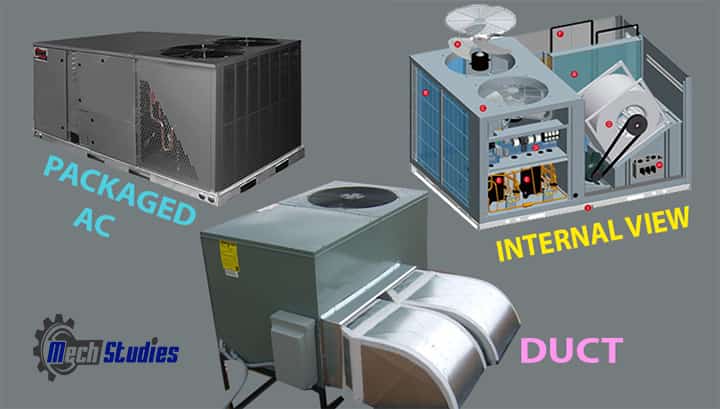
Chilled Water System
In the case of large-scale applications like industrial or commercial applications, the chilled water system is used. Mainly high capacity requirements or varying demands application chilled water system is the best choice. In a chilled water system, the main refrigeration cycle is the same as split air conditioners or packaged air conditioners.
However, there is a chiller which is nothing but an evaporator as well as the compressor, and condenser assembly. Due to its large capacity, the design of the chiller is different from other air conditioners.
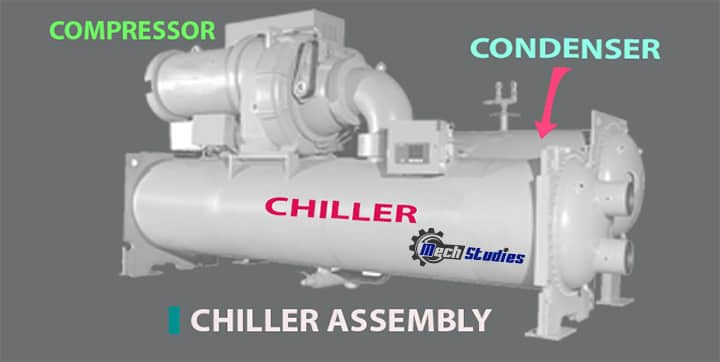
The basics of the chilled water system are,
- A separate water circuit is used to get the cooling effects from the evaporator.
- The evaporator exchanges heat between refrigerant and water instead of refrigerant and air.
- Later on, the refrigerant passes through the compressor and is cooled in the condensers.
- The condenser is cooled by air or plate heat exchangers or cooling towers based on the capacity as well as design requirements.
- Condenser water circulation is by condenser water pumps.
- Chiller produces chilled water, normally at 7 deg. C and return at 12 deg. C at the chiller after heat pick up from the conditioned space.
- Air handling units (AHU) that handle or circulate air is to be placed in the conditioned space.
- Each AHU consists of cooling coils, fan, filters, etc., and water is circulated from the chiller to the cooling coil of the AHU.
- The cooling coil in AHU picked up the heat from the air and air gets cooled and water gets hot by receiving the heat from the air.
- Hot water around 12 deg. C returned back to the chillers and cooled in the chillers.
- Water circulation from the chillers to AHU by chilled water pumps.
- This circulation is controlled by control systems, various valves, etc.
A simple chilled water system is indicated in a diagram for getting an idea.
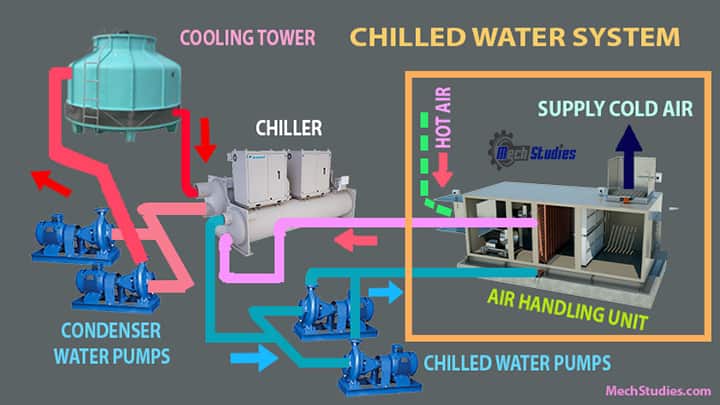
Conclusion
So, we have learned how does different air conditioner works, along with a few practical examples. Any doubt, don’t hesitate to write to us! Anyways, try to solve the quizzes to test the core of learning! Cheers!

Some really interesting details you have written. Aided me a lot, just what I was looking for : D.
Wow! This could be one particular of the most useful blogs We have ever arrive across on this subject. Basically Fantastic. I am also an expert in this topic so I can understand your hard work.
Writing a great article takes commitment and pride in one’s work. It’s apparent that this writer has it together. Each point is well formatted. The grammar and spelling is excellent.
Thanks for some other excellent article. Where else could anyone get that kind of information in such a perfect way of writing? I’ve a presentation next week, and I am at the look for such info.
Any other spots you possibly could think of for further details?
Heya i’m for the first time here. I came across this board and I find It truly useful & it helped me out much. I hope to offer something back and help others like you aided me.
Aw, this was a very nice post. In thought I want to put in writing like this moreover ?taking time and actual effort to make a very good article?however what can I say?I procrastinate alot and certainly not appear to get one thing done.
I simply learned all about your internet site the other day and that i happen to be reading through it regularly. You have a a lot of extra practical information on the site and that i benefit from the particular type of the web page furthermore. Keep the good work!
I loved your article.Really thank you! Really Cool.
I’ll immediately grasp your rss as I can’t find your e-mail subscription hyperlink or e-newsletter service. Do you have any? Kindly allow me realize in order that I could subscribe. Thanks.
Hi my family member! I want to say that this post is awesome, great written and come with almost all important infos. I’d like to look extra posts like this.